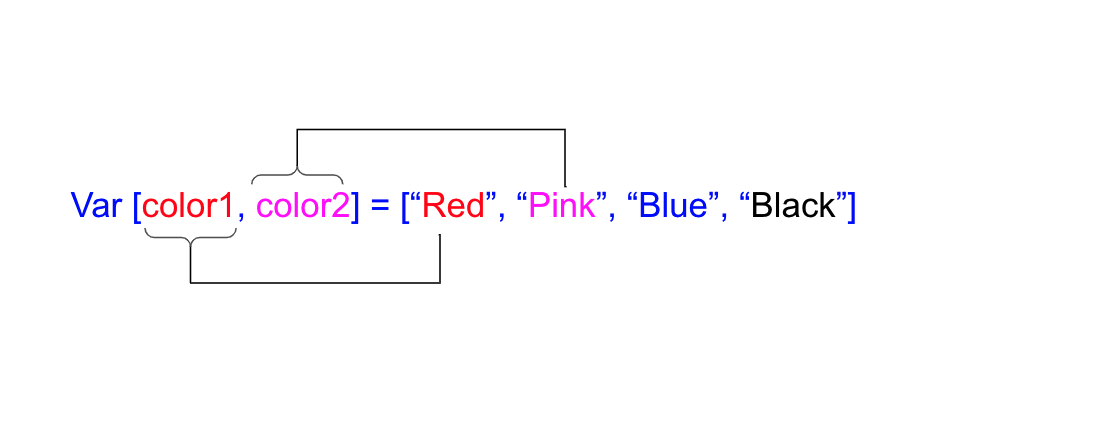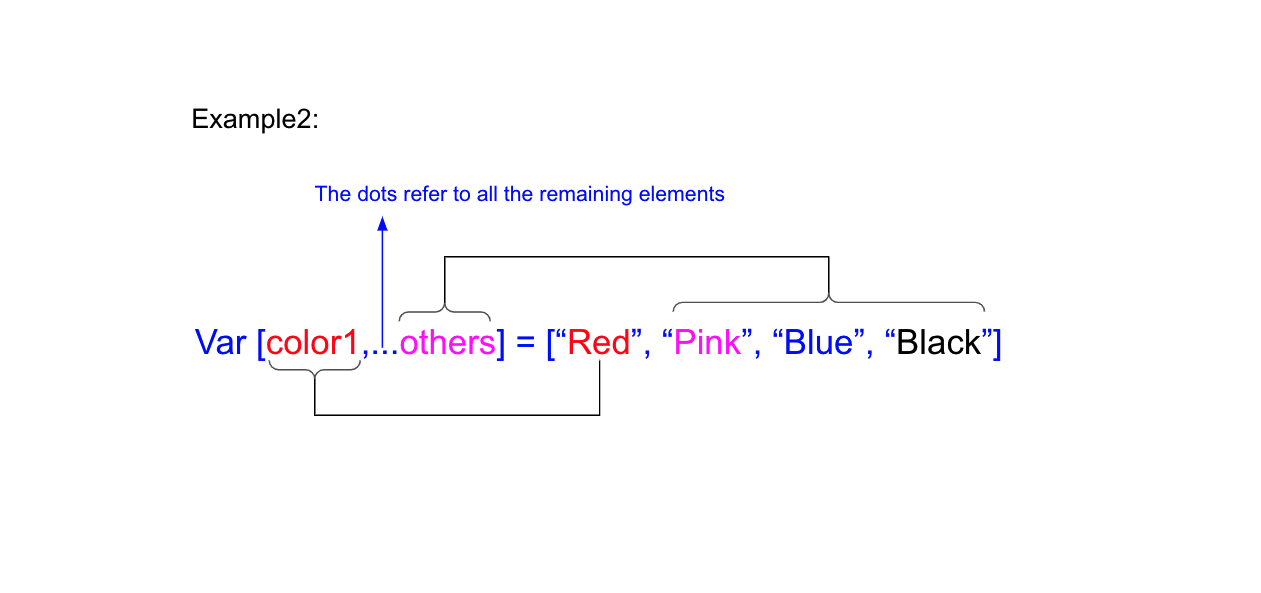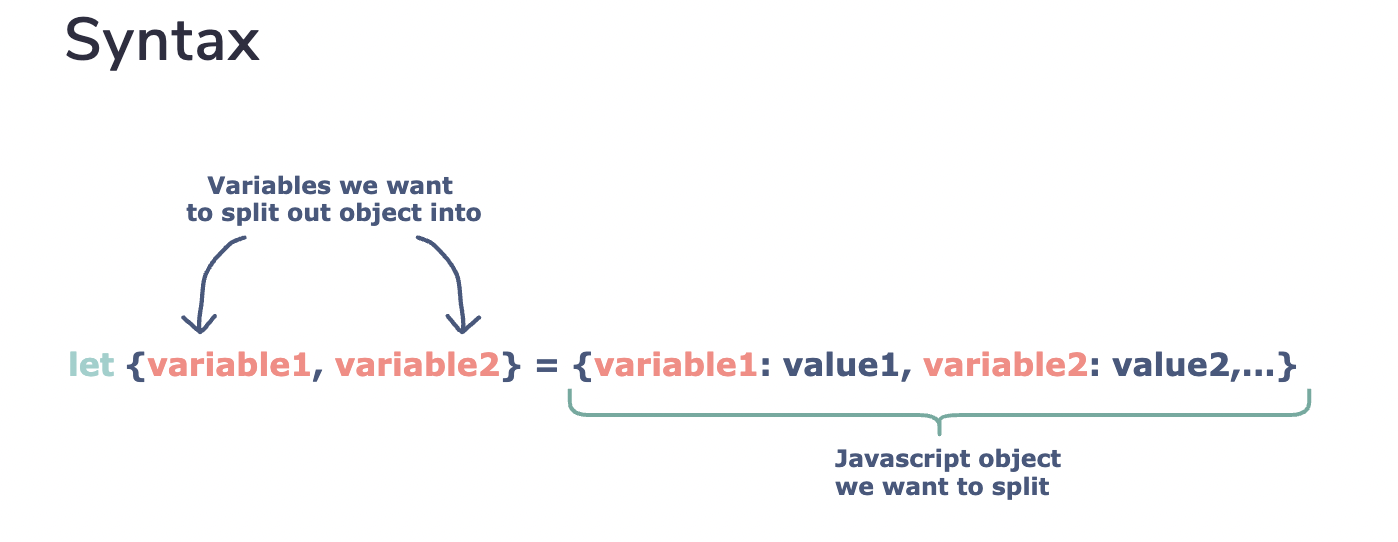We have updated the content of our program. To access the current Software Engineering curriculum visit curriculum.turing.edu.
Intro to Destructuring
Learning Goals
- Implement destructuring on arrays and objects
Vocabulary
-
Destructuringis a feature introduced with ES6. A feature that enables you to break down a structure, like an array or object, and store its components in variables. -
Array destructuringis a javascript expression that reduces arrays to smaller atoms where the contents of the array can be easily accessed and referenced by variables. The reduction may only be to 1 level or to the least level (depending on the depth of the array and how far you want to destructure it). -
Object destructuringis a feature in JavaScript that allows you to extract values from objects and assign them to variables in a more concise and convenient way. Even better, object destructuring can extract multiple properties in a single statement, can access properties from nested objects, and can set a default value if the property doesn’t exist. -
The
spread operatoris a new addition to the set of operators in JavaScript ES6. It takes in an iterable (e.g an array) and expands it into individual elements.
Starting with Array Destructuring
Warm Up
In your notebooks write what do you think these logs will return?
const colors = ["Red","Pink","Blue","Black"] //Array to be destructured
const [color1, color2] = colors //Destructuring
console.log(color1)
console.log(color2)
The Answer
This is what happen in the code above.

A few more scenarios
Let’s now see a few techniques to use array destructuring efficiently.
In breakout groups, predict what the console.logs with give, run it, and then discuss the difference between these two examples.
Example 1:
const colors = ["Red","Pink","Blue","Black"] //Array to be destructured
const [,color1,, color2] = colors //Focus on the use of extra commas to skip through elements
console.log(color1)
console.log(color2)
Example2:
const colors = ["Red","Pink","Blue","Black"] //Array to be destructured
const [color1, ...others] = colors //Focus on the use of ... to assign remaining elements to an array
console.log(color1)
console.log(others)
The Answer
Assigning an Array to a variable


Why do we use destructuring?
Destructuring assignment allows you to assign the properties of an array or object to variables using syntax that looks similar to array or object literals. This syntax can offer more clarity than the traditional way of accessing values by their index.
Without destructuring assignment, you might access the first three items in an array like this:
const first = bigArr[0];
const second = bigArr[1];
const third = bigArr[2];
Review
Return to your notebooks and write what do you think this logs will return?
const bigArr = ["number", 4,5,6]
const [ important, ...secondArr ] = bigArr;
console.log(important, secondArr)
Object Destructuring
The right side of the statement contains the Javascript object that we want to split into variables; the left side contains a “pattern” for corresponding properties of the object. This “pattern” is usually a list of variable names.
Warm Up
In breakout rooms, write what you think will be logged?
const user = { // Object we want to destructure
firstName: 'Jon',
lastName: 'Doe',
dateOfBirth: '1990'
};
// Destructuring the object into our variables
const { firstName, lastName, dateOfBirth } = user;
console.log( firstName, lastName, dateOfBirth);
After running it, write what do you think the above code would look like in ES5?
Breaking This Down Further

In a destructuring expression L = R, we take the right value R, and break it down so that the new variables in L can be assigned a value. The variable names on the left side must match the property names on the right.
In ES5, this would look like:
const firstName = user.firstName;
const lastName = user.lastName;
console.log(firstName);
console.log(lastName);
🌶️ Consider a Spicier Example 🌶️
Imagine we have a more complex user object and want to destructure properties nested within:
const user = {
firstName: "John",
lastName: "Doe",
age: 30,
address: {
street: "123 Main St",
city: "Anytown",
state: "CA",
zipCode: "12345"
},
contact: {
emailAddress: "john.doe@example.com",
phone: "555-123-4567"
},
preferences: {
theme: "dark",
language: "en",
notifications: {
email: true,
sms: false
}
}
};
What would the syntax look like to destructure the email and sms properties from our user object?
Assigning to a variable with default:
We can also assign default values to variables whose keys may not exist in the object we want to destructure. This will prevent our variable from having an undefined value being assigned to it. Let’s take a look at an example!
Take a Look At The Data Below:
const newspaperArticles = [
{
name: "COVID-19 Vaccines Rollout",
tags: ["COVID-19", "vaccine", "pandemic"],
imageUrl: "https://example.com/covid-vaccine.jpg"
},
{
name: "Climate Change Summit",
tags: ["climate change", "environment", "summit"],
imageUrl: undefined
},
{
name: "Economic Recovery Strategies",
tags: ["economy", "recovery", "pandemic"],
imageUrl: undefined
},
{
name: "Space Exploration Milestone",
tags: ["space exploration", "NASA", "satellite"],
imageUrl: "https://example.com/space-exploration.jpg"
}
];
Note that sometimes we get inconsistent data from APIs where information is not always provided such as the image URLs above.
- Imagine if we needed to iterate through this data and display them on a page. What kind of logic might you use for the image URLs that are missing a link?
Solving This With Destructuring
// Our goal is to iterate through this array of newspaper articles and display them on a page:
// Note the logs and how some image URLs are missing a path.
newspaperArticles.forEach(newspaper => {
const { name, description, tags, imageUrl } = newspaper;
console.log(imageUrl);
section.innerHTML += // Insert articles here
})
// Let's update this so that we have a default image if no image URL is given
newspaperArticles.forEach(newspaper => {
const { name, description, tags, imageUrl = './images/no-image.svg' } = newspaper;
console.log(imageUrl);
section.innerHTML += // Insert articles here
})
Passing an object as an argument:
What if you want to destructuring an object as an argument?
const user = { // Object we want to destructure
firstName: 'Jon',
lastName: 'Doe',
dateOfBirth: '1990'
};
const logUser = ({ firstName, lastName, dateOfBirth }) => {
console.log(firstName)
console.log(lastName)
console.log(dateOfBirth)
}
logUser(user)
Exit Ticket
- How do we destructuring an object?
- How do we destructuring an object?
- How do we use spread operator?